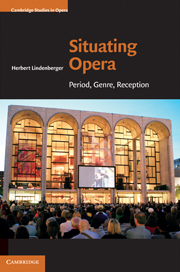Book contents
- Frontmatter
- Contents
- Acknowledgements
- Prologue
- 1 Anatomy of a warhorse: Il trovatore from A to Z
- 2 On opera and society (assuming a relationship)
- 3 Opera and the novel: antithetical or complementary?
- 4 Opera by other means
- 5 Opera and/as lyric
- 6 From separatism to union: aesthetic theorizing from Reynolds to Wagner
- 7 Toward a characterization of modernist opera
- 8 Anti-theatricality in twentieth-century opera
- 9 A brief consumers' history of opera
- Epilogue
- WORKS CITED
- Index
2 - On opera and society (assuming a relationship)
Published online by Cambridge University Press: 05 August 2011
- Frontmatter
- Contents
- Acknowledgements
- Prologue
- 1 Anatomy of a warhorse: Il trovatore from A to Z
- 2 On opera and society (assuming a relationship)
- 3 Opera and the novel: antithetical or complementary?
- 4 Opera by other means
- 5 Opera and/as lyric
- 6 From separatism to union: aesthetic theorizing from Reynolds to Wagner
- 7 Toward a characterization of modernist opera
- 8 Anti-theatricality in twentieth-century opera
- 9 A brief consumers' history of opera
- Epilogue
- WORKS CITED
- Index
Summary
Why should we even speak of opera and society in the same breath? Is there, for instance, a special affinity between these two terms, and if so, is it different from or more intense than the relationships we seek to establish between other artistic forms and society – between, for instance, painting and society, comedy and society, or, to cite the title of a famous essay by Theodor Adorno, lyric and society?
As we listen to these various combinations, the phrase “opera and society” seems particularly amenable to discussion. With painting, for example, one is faced with a multitude of forms, each rooted in a particular social context, from the animals depicted on the caves of Lascaux to the political messages drawn by muralists on barrio walls. Opera, by contrast, seems comfortably circumscribed. It encompasses an easily definable history extending back four hundred years in Europe and the Americas. It has flourished continuously within a discernible institution, the opera house, though also, at least in its earlier years, within aristocratic courts. And despite the substantial differences in national traditions of opera, the particular roles assigned to those who create and sustain it – impresario, singers, librettist, composer – have maintained a degree of constancy over these four centuries rarely to be found in other art forms.
- Type
- Chapter
- Information
- Situating OperaPeriod, Genre, Reception, pp. 44 - 61Publisher: Cambridge University PressPrint publication year: 2010



